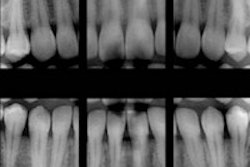
The high cost of x-ray units makes them economically out of reach for some practices, particularly those in rural areas with small patient bases or in developing countries. Fortunately, portable radiography systems can bring these services to practices that lack them. But do portable units perform as well as their stationary counterparts?
Researchers from the department of public health dentistry at D.J. College of Dental Sciences and Research in Uttar Pradesh, India, sought to answer that question with a literature review published in the Journal of Clinical and Diagnostic Research (January 2014, Vol. 8:1, pp. 303-308).
"Portable radiographic machines may prove to be a landmark in community settings, for serving the underserved," wrote lead author Dr. Swati Jain and colleagues. "They have a comparable image quality as that of conventional wall-mounted machines."
Overall, the researchers were optimistic about the potential of handheld x-ray systems to increase the standard of care, but this was tempered by safety concerns: "They also have drawbacks with regards to user radiation safety," the researchers noted.
Given the limited opportunities to incorporate conventional radiography units into rural practices, the researchers sought to evaluate the image quality of portable devices for the benefit of those working in public health dentistry.
For their literature review, the authors searched for articles about portable radiographic units or articles that compared such units with conventional, wall-mounted x-ray units. No such articles existed before 1978, so that year became their starting point, with 2012 serving as the cutoff year. They used Google Scholar, the Cochrane database, and PubMed to find the articles included in their review. Any articles that did not explain the feasibility of portable dental radiographic units were excluded. Of 23 initial abstracts, 10 fulfilled the criteria: six clinical studies, two review articles, and two reports.
In one study in the Journal of the Michigan Dental Association, the researchers compared radiographs from the Nomad (Aribex) portable dental x-ray device with images from the GX-770 (Gendex) wall-mounted x-ray system (February 2009, Vol. 91:2, pp. 54-58). The images were evaluated by three different reviewers without revealing which machine produced which images. The "image quality for radiographs ... appeared to be similar in a variety of clinical situations," the authors noted, nor was motion artifact an issue.
Another study focused on the possibility of leakage radiation with the same battery-operated portable x-ray system, using a dual-energy x-ray absorptiometry (DEXA) phantom and a water canon (Dentomaxillofacial Radiology, February 2008, Vol. 37:2, pp. 109-112). Not only were the backscatter measurements around the operator well below the maximum permissible radiation leakage allowed by U.S. Food and Drug Administration guidelines, the quality of the images produced was the same as with standard x-ray equipment.
The latter conclusion in that study proved to be the norm. "All the clinical studies which were under consideration gave unanimously a single result of a comparable image quality of portable dental radiographic machines with that of conventional wall-mounted x-ray units," the authors wrote.
However, there were some concerns about radiation exposure in some reports. Therefore, "when portable dental x-ray systems are used, it is recommended that the x-ray machine which is attached with a backscatter shield and a longer cone should be selected" and lead gloves should be worn to reduce the operator's radiation dose, the researchers concluded. They encouraged more research into user radiation safety, as well as more research in general about the devices.
Even with a limited database, the researchers were convinced of the feasibility of using these units in a variety of clinical situations. They were also enthusiastic about their use in community settings and their ability to provide services to communities that historically have not had access.
"Based on the available limited data, their future looks promising," the group concluded.



















